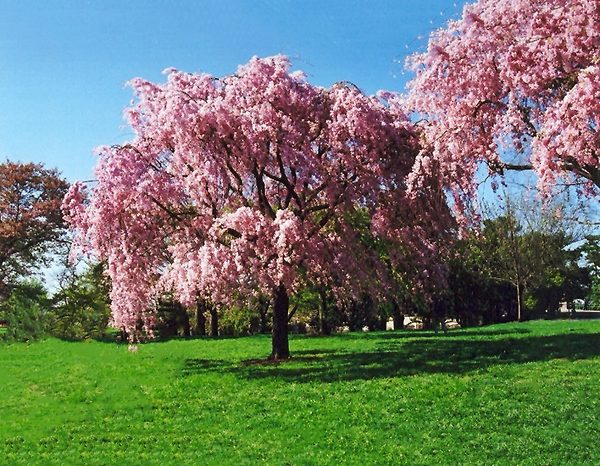The Stunning Weeping Cherry Tree
Prunus subhirtella (Weeping Cherry Tree) originated in East Asia thousands of years ago and primarily developed in Japan and China. For centuries people have cultivated this elegant species which features prominently in ancient religious ceremonies as well as artwork and poetry. Japanese culture frequently connects the species with ideas of renewal and transient beauty. Botanists officially described the species in the 18th century yet its cultivation history extends much further into the past. During the 19th century plant enthusiasts and botanists introduced this graceful species to Western nations where they aimed to incorporate it into European and American gardens.
Weeping Cherry Tree Medicinal and Traditional Uses
The weeping Cherry Tree serves mainly as an ornamental species, but historical uses reveal its medicinal properties. Eastern traditional medicine practices have long recognized the bark and flowers as valuable for their beneficial potential. Herbal preparations made from bark extracts serve respiratory health needs by soothing coughs while helping to treat minor throat irritations. They have added blossoms to certain teas and infusions which people believe help with relaxation and well-being. Although it does not represent a central component of today's drug development its historical use in herbal treatments contributes to its extensive cultural heritage.
When It Was First Discovered
The official classification of Prunus subhirtella occurred in the 18th century but evidence shows it existed in Asia long before that time. Historical Japanese documents from the Heian period (794-1185) indicate that this species was cultivated in both palace gardens and temple courtyards. European botanists discovered this species during trade journeys and transported specimens to their native lands, which became highly sought after by collectors and growers. During the late 1800s and early 1900s the species reached North America where it continues to be a popular decorative element in both parks and gardens.
Weeping Cherry Tree A Staple in Landscape Design
Prunus subhirtella's enduring popularity in landscaping reflects both its lasting beauty and its ability to adapt. The elegant display of pink or white blossoms cascading from the gracefully arching branches of this plant establishes a focal point in any environment. Gardens and parks commonly feature this plant along walkways where its distinctive outline captures attention throughout the year. Landscape designers frequently employ Prunus subhirtella as a specimen plant, and its natural elegance becomes the centerpiece of their designs. Japanese-style gardens often use this plant because it enhances rock formations and water features together with other traditional garden elements. When planted in expansive landscapes evergreens serve as a contrasting backdrop which magnifies the plant's fragile floral display.

The Unique and Striking Appearance
Weeping Cherry Tree impresses with its elegant cascading structure. Its branches become draped with delicate blossoms that shift in color from soft pink to pure white during early spring. The abundant blooms of these flowers create an impressive display that persists for numerous weeks. The period after blooming brings forth lush green foliage which transforms into golden-yellow leaves during autumn. The tree maintains its stunning appearance throughout the winter months as its twisted branches enhance the garden's architectural appeal. The tree remains popular for ornamental use due to its slender and pendulous branches combined with fine foliage texture, which creates an otherworldly elegance throughout its seasonal changes.
Rare Wildlife It Attracts
Prunus subhirtella provides essential support to local wildlife beyond its visual beauty. Its blooming period transforms the tree into a sanctuary for pollinators, which draws bees, butterflies, and other helpful insects. Its nectar serves as an essential early-season food source for specific native bee species, which makes it an important element in pollinator-friendly landscapes. Small fruit development during late summer and fall attracts bird populations to the tree. Various songbirds including robins and cedar waxwings eat these fruits which humans do not usually consume. The tree provides small birds with nesting spaces and protection through its dense branches which bolsters its ecological role.
Resilience and Hardiness
The impressive hardiness of Prunus subhirtella stands as a key reason for its long-lasting popularity. This tree successfully grows across multiple climate conditions as it endures cold winters and hot summers without difficulty. The tree grows well in USDA hardiness zones 5 through 8 thus making it suitable for various growing environments. This species stands out among ornamentals because it needs just occasional pruning while other species demand meticulous maintenance for health and shape. Its resistance to numerous common pests and diseases makes it more suitable for different landscape types. This specimen promises to endure for multiple decades when given proper care and delivers its extraordinary beauty and elegance to successive generations.
Weeping Cherry Tree A Timeless Legacy
Weeping Cherry Tree represents an enduring embodiment of beauty while demonstrating both resilience and ecological significance. From ancient temple gardens to present-day parks and home gardens this image continues to capture and motivate people. The combination of its fragile flowers and elegant shape along with its power to draw various forms of wildlife makes Prunus subhirtella an appreciated feature in any environment. The combination of its historical importance medicinal value and breathtaking appearance makes this species a genuine representation of nature’s lasting magnificence.